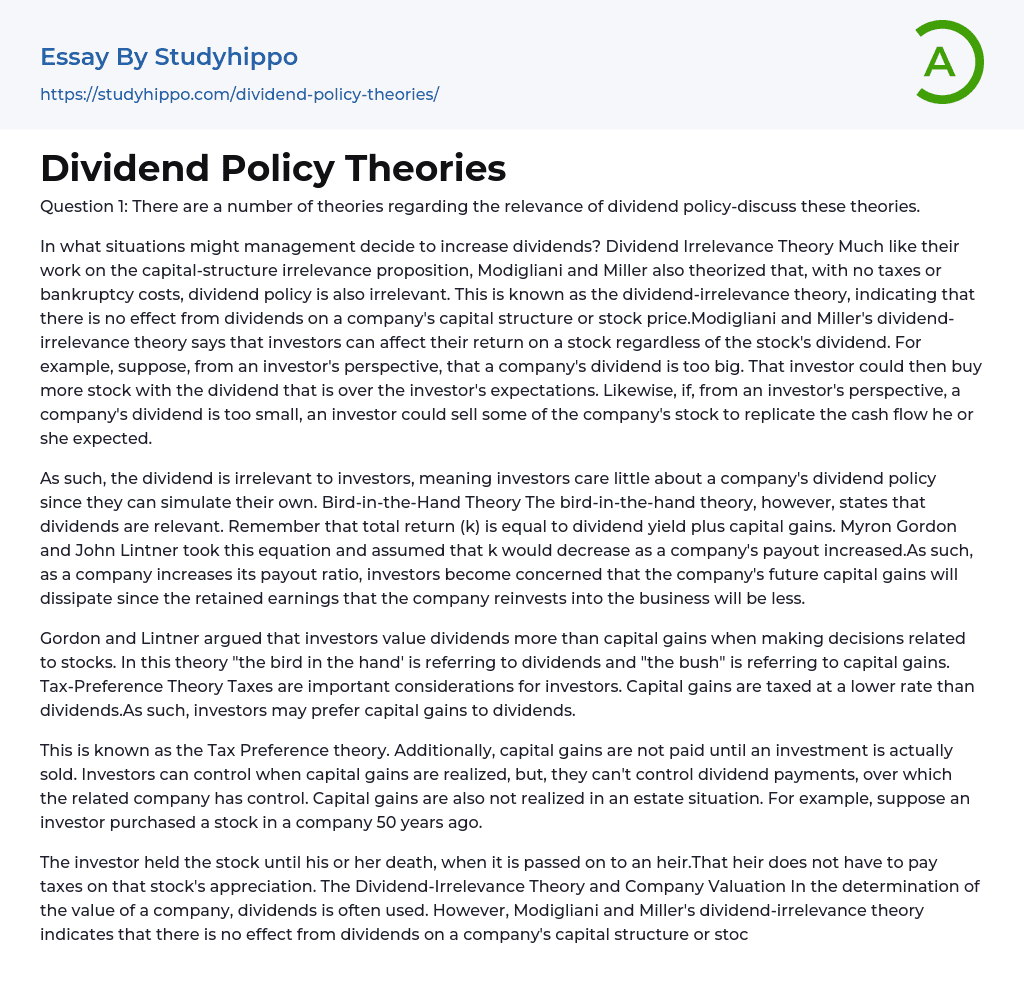Discuss the various theories regarding the importance of dividend policy in Question 1.
Under what circumstances would management opt to increase dividends? The Dividend Irrelevance Theory, analogous to their findings about capital-structure irrelevance, posits that dividend policy is irrelevant in situations where there are no bankruptcy costs or taxes. This theory, called the dividend-irrelevance theory, establishes that a company's capital structure or stock price remains unaffected by their dividends. Modigliani and Miller's dividend-irrelevance theory affirms that investors can influence their returns on specific stocks irrespective of the dividends offered. To illustrate, if the dividend amount exceeds an investor's expectations, they can purchase additional stocks with the excess. Correspondingly, if the dividend amount falls short of their projections, they may sell some of the stock to recreate the envisaged cash flow.
In
...vestors often overlook a company's dividend policy as they are able to create their own. However, the bird-in-the-hand theory highlights the importance of dividends. Total return (k) is made up of both dividend yield and capital gains. Myron Gordon and John Lintner assumed that k will decrease as a company's payout increases. This means that when a company increases its payout ratio, investors worry that the retained earnings will be less, resulting in fewer future capital gains.
Gordon and Lintner introduced the concept that dividends hold greater significance for investors in stock selection, through their terms "the bird in the hand" for dividends and "the bush" for capital gains. Tax-Preference Theory suggests that investors may prefer capital gains due to lower tax rates compared to dividends.
The Tax Preference theory explains that investors have control over capital gains, which are not paid until an investment is sold. Unlik
dividends, this type of gain cannot be realized in estate situations. To illustrate, let's consider an investor who purchased shares in a company five decades ago.
The Modigliani and Miller theory states that dividends have no influence on a company's capital structure or stock price. Rather, the return on a stock can be affected by investors regardless of the dividend offered. Furthermore, if an individual retains ownership of a stock until death and then passes it on to an heir, there are no tax liabilities associated with the appreciation of the stock.
The size of a company's dividend can be manipulated by investors to adjust their stock holdings based on whether it is too high or low. This renders the company's own dividend policy irrelevant as investors can create their own policy. According to the theory of dividend irrelevance, a company's capital structure and stock price are not affected by its dividend policy in the absence of taxes or bankruptcy expenses.
The dividend-irrelevance theory proposed by Modigliani and Miller suggests that investors are able to manipulate their return on a stock irrespective of its dividend policy, rendering the dividend insignificant. Thus, when making investment decisions, investors do not take into account a company's dividend policy as they can replicate their own.
- Investing essays
- Asset essays
- Depreciation essays
- Discounted Cash Flow essays
- Foreign Direct Investment essays
- Funds essays
- Internal Rate Of Return essays
- Revenue essays
- Day Trading essays
- Futures Trading essays
- Capital market essays
- Million essays
- Payment essays
- Rate Of Return essays
- Funding essays
- Hedge Fund essays
- Bank essays
- Banking essays
- Corporate Finance essays
- Credit Card essays
- Currency essays
- Debt essays
- Donation essays
- Enron Scandal essays
- Equity essays
- Financial Accounting essays
- Financial Crisis essays
- Financial News essays
- Financial Ratios essays
- Financial Services essays
- Forecasting essays
- Foreign Exchange Market essays
- Free Market essays
- Gold essays
- Investment essays
- Legacy essays
- Loan essays
- Market Segmentation essays
- Money essays
- Personal finance essays
- Purchasing essays
- Retirement essays
- Shareholder essays
- Stock Market essays
- Supply And Demand essays
- Venture Capital essays
- Activism essays
- Communism essays
- Conservatism essays
- Liberalism essays




